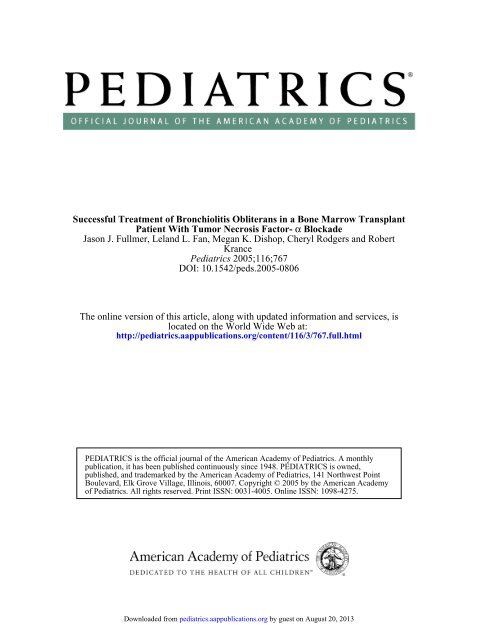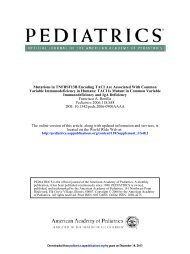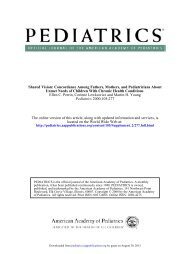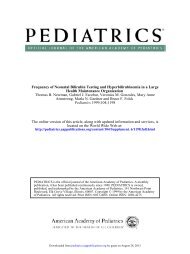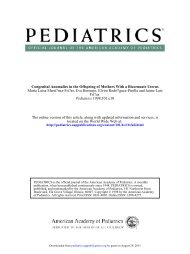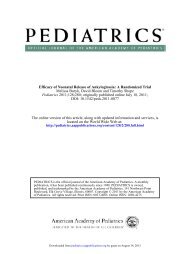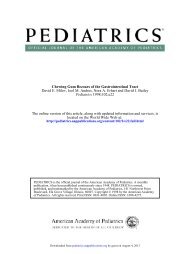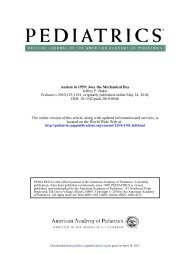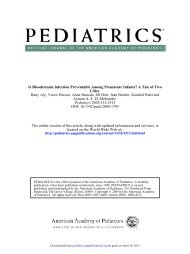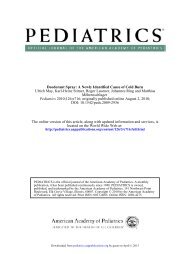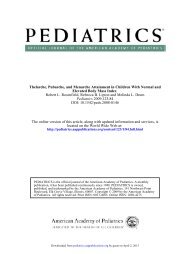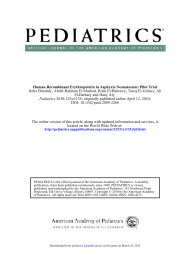Successful Treatment of Bronchiolitis Obliterans in a ... - Pediatrics
Successful Treatment of Bronchiolitis Obliterans in a ... - Pediatrics
Successful Treatment of Bronchiolitis Obliterans in a ... - Pediatrics
You also want an ePaper? Increase the reach of your titles
YUMPU automatically turns print PDFs into web optimized ePapers that Google loves.
<strong>Successful</strong> <strong>Treatment</strong> <strong>of</strong> <strong>Bronchiolitis</strong> <strong>Obliterans</strong> <strong>in</strong> a Bone Marrow Transplant<br />
Patient With Tumor Necrosis Factor- α Blockade<br />
Jason J. Fullmer, Leland L. Fan, Megan K. Dishop, Cheryl Rodgers and Robert<br />
Krance<br />
<strong>Pediatrics</strong> 2005;116;767<br />
DOI: 10.1542/peds.2005-0806<br />
The onl<strong>in</strong>e version <strong>of</strong> this article, along with updated <strong>in</strong>formation and services, is<br />
located on the World Wide Web at:<br />
http://pediatrics.aappublications.org/content/116/3/767.full.html<br />
PEDIATRICS is the <strong>of</strong>ficial journal <strong>of</strong> the American Academy <strong>of</strong> <strong>Pediatrics</strong>. A monthly<br />
publication, it has been published cont<strong>in</strong>uously s<strong>in</strong>ce 1948. PEDIATRICS is owned,<br />
published, and trademarked by the American Academy <strong>of</strong> <strong>Pediatrics</strong>, 141 Northwest Po<strong>in</strong>t<br />
Boulevard, Elk Grove Village, Ill<strong>in</strong>ois, 60007. Copyright © 2005 by the American Academy<br />
<strong>of</strong> <strong>Pediatrics</strong>. All rights reserved. Pr<strong>in</strong>t ISSN: 0031-4005. Onl<strong>in</strong>e ISSN: 1098-4275.<br />
Downloaded from pediatrics.aappublications.org by guest on August 20, 2013
<strong>Successful</strong> <strong>Treatment</strong> <strong>of</strong> <strong>Bronchiolitis</strong> <strong>Obliterans</strong> <strong>in</strong> a Bone Marrow<br />
Transplant Patient With Tumor Necrosis Factor- Blockade<br />
Jason J. Fullmer, MD*; Leland L. Fan, MD*; Megan K. Dishop, MD‡; Cheryl Rodgers, RNP§;<br />
and Robert Krance, MD§<br />
ABSTRACT. <strong>Bronchiolitis</strong> obliterans (BO) <strong>in</strong> children<br />
is a rare, <strong>in</strong>flammatory/fibros<strong>in</strong>g process <strong>in</strong>volv<strong>in</strong>g the<br />
small airways that <strong>of</strong>ten results <strong>in</strong> progressive, irreversible<br />
obstructive pulmonary disease. Because treatment<br />
has focused ma<strong>in</strong>ly on supportive care and generally<br />
unsuccessful immunosuppression, children with BO experience<br />
significant morbidity and mortality. We report a<br />
case <strong>of</strong> biopsy-proven BO after bone marrow transplantation<br />
<strong>in</strong> a child who, after failed corticosteroid therapy,<br />
was treated with <strong>in</strong>fliximab, a monoclonal antibody with<br />
b<strong>in</strong>d<strong>in</strong>g specificity for human tumor necrosis factor-.<br />
With <strong>in</strong>itiation <strong>of</strong> treatment, her pulmonary symptoms<br />
and radiographic and spirometric evidence <strong>of</strong> BO resolved.<br />
N<strong>in</strong>e months later, she rema<strong>in</strong>s asymptomatic<br />
and shows no evidence <strong>of</strong> pulmonary decompensation.<br />
This case illustrates a successful treatment <strong>of</strong> BO with<br />
selective tumor necrosis factor- blockade. <strong>Pediatrics</strong><br />
2005;116:767–770; bone marrow transplant, bronchiolitis<br />
obliterans, tumor necrosis factor-alpha.<br />
ABBREVIATIONS. BO, bronchiolitis obliterans; BMT, bone marrow<br />
transplantation; TNF-, tumor necrosis factor-; GVHD,<br />
graft-versus-host disease; HRCT, high-resolution computed tomography;<br />
IVIG, <strong>in</strong>travenous immunoglobul<strong>in</strong>; RSV, respiratory<br />
syncytial virus; FEV 1 , forced expiratory volume <strong>in</strong> 1 second; IL,<br />
<strong>in</strong>terleuk<strong>in</strong>.<br />
<strong>Bronchiolitis</strong> obliterans (BO), also known as constrictive<br />
bronchiolitis or obliterative bronchiolitis,<br />
is a rare pulmonary disorder characterized<br />
histologically by an <strong>in</strong>flammatory/fibros<strong>in</strong>g<br />
process that constricts and ultimately obliterates the<br />
small airways. 1 The functional loss <strong>of</strong> these airways<br />
results <strong>in</strong> the <strong>in</strong>sidious development <strong>of</strong> chronic<br />
cough and prolonged wheeze, <strong>of</strong>ten progress<strong>in</strong>g to<br />
severe respiratory distress. Known causes <strong>of</strong> BO <strong>in</strong>clude<br />
<strong>in</strong>fection (the most common cause <strong>in</strong> children),<br />
particularly with adenovirus and Mycoplasma;<br />
chronic aspiration; toxic fume <strong>in</strong>halation; and drugs.<br />
BO is also a well-described complication <strong>in</strong> allograft<br />
recipients undergo<strong>in</strong>g lung, heart-lung, and bone<br />
*From the Sections <strong>of</strong> Pulmonary Medic<strong>in</strong>e, ‡Pathology, and §Hematology<br />
and Oncology, Department <strong>of</strong> <strong>Pediatrics</strong>, Texas Children’s Hospital and<br />
Baylor College <strong>of</strong> Medic<strong>in</strong>e, Houston, Texas.<br />
Accepted for publication May 18, 2005.<br />
doi:10.1542/peds.2005-0806<br />
No conflict <strong>of</strong> <strong>in</strong>terest declared.<br />
Address correspondence to Leland L. Fan, MD, Department <strong>of</strong> <strong>Pediatrics</strong>,<br />
Pulmonology Section, Texas Children’s Hospital, 6621 Fann<strong>in</strong>, CC 1040.00,<br />
Houston, TX 77030. E-mail: llfan@texaschildrenshospital.org<br />
PEDIATRICS (ISSN 0031 4005). Copyright © 2005 by the American Academy<br />
<strong>of</strong> <strong>Pediatrics</strong>.<br />
marrow transplantation (BMT) and <strong>in</strong> patients with<br />
Stevens-Johnson syndrome. 1,2<br />
Children with BO have a highly variable prognosis,<br />
with significant long-term morbidity reported <strong>in</strong><br />
78% to 92% <strong>of</strong> patients, depend<strong>in</strong>g on the etiology <strong>of</strong><br />
the <strong>in</strong>itial <strong>in</strong>sult. 3,4 Therapeutic <strong>in</strong>terventions <strong>in</strong> patients<br />
develop<strong>in</strong>g severe BO have generally been disappo<strong>in</strong>t<strong>in</strong>g,<br />
and treatment rests primarily on supportive<br />
care. Although anti-<strong>in</strong>flammatory therapy<br />
such as corticosteroids, chloroqu<strong>in</strong>e, and hydroxychloroqu<strong>in</strong>e<br />
has been tried <strong>in</strong> small cl<strong>in</strong>ical trials and<br />
case reports 4–6 <strong>in</strong> an attempt to modify the disease<br />
before fibrosis develops, this approach has met with<br />
m<strong>in</strong>imal success. The rarity <strong>of</strong> BO <strong>in</strong> children makes<br />
prospective, randomized, controlled trials difficult.<br />
Thus, it is almost impossible to discern the true therapeutic<br />
value <strong>of</strong> established immunosuppressive<br />
agents such as corticosteroids and very difficult to<br />
<strong>in</strong>vestigate new therapeutic options.<br />
Studies <strong>in</strong>vestigat<strong>in</strong>g the molecular signal<strong>in</strong>g important<br />
<strong>in</strong> the development <strong>of</strong> the fibroproliferative<br />
stage <strong>of</strong> BO <strong>in</strong> both animal models and human subjects<br />
have implicated several pro-fibrotic growth factors.<br />
One <strong>of</strong> these, tumor necrosis factor- (TNF-), a<br />
mesenchymal growth factor that is known to participate<br />
<strong>in</strong> matrix remodel<strong>in</strong>g, has been shown to be<br />
elevated <strong>in</strong> the early stage <strong>of</strong> BO <strong>in</strong> human and<br />
animal studies. 7,8 Recent studies <strong>in</strong> experimental<br />
mammalian models <strong>of</strong> BO, and models <strong>of</strong> graft-versus-host<br />
disease (GVHD) with acute lung <strong>in</strong>jury,<br />
have shown that blockade <strong>of</strong> TNF- us<strong>in</strong>g a TNF-soluble<br />
receptor (TNFR:Fc) significantly reduced epithelial<br />
<strong>in</strong>jury and lumenal obstruction. 7,9 We present<br />
a case <strong>of</strong> develop<strong>in</strong>g, biopsy-proven BO after BMT<br />
that was treated with <strong>in</strong>fliximab, a monoclonal antibody<br />
with b<strong>in</strong>d<strong>in</strong>g specificity for TNF-, after failed<br />
corticosteroid therapy. She responded symptomatically<br />
and showed reversal <strong>of</strong> airway obstruction and<br />
improvement <strong>in</strong> lung high-resolution computed tomography<br />
(HRCT) f<strong>in</strong>d<strong>in</strong>gs.<br />
CASE REPORT<br />
A previously healthy, 8-year-old Hispanic girl developed severe<br />
aplastic anemia with markedly hypocellular bone marrow<br />
(5% cellularity) and cytogenetic evidence <strong>of</strong> a t(9;22) translocation<br />
(BCR-ABL fusion product <strong>in</strong> 11% <strong>of</strong> cells). She subsequently<br />
underwent matched, unrelated BMT. Her course was complicated<br />
by grade I GVHD with sk<strong>in</strong> stage II. She was treated with tacrolimus,<br />
<strong>in</strong>travenous immunoglobul<strong>in</strong> (IVIG), and corticosteroids. She<br />
has rema<strong>in</strong>ed on tacrolimus and IVIG throughout the course described<br />
<strong>in</strong> this case report. Two months after BMT, she was hospitalized<br />
for 5 days with a respiratory syncytial virus (RSV) <strong>in</strong>fection <strong>of</strong><br />
PEDIATRICS Vol. 116 No. 3 September 2005 767<br />
Downloaded from pediatrics.aappublications.org by guest on August 20, 2013
the lower respiratory tract and treated with ribavir<strong>in</strong>. Dur<strong>in</strong>g and<br />
after this illness, she developed persistent, productive cough, which<br />
was evaluated 2 1 ⁄2 months post-BMT. Compared with previously<br />
normal spirometry, her forced expiratory volume <strong>in</strong> 1 second (FEV 1 )<br />
decreased by 11% to 85% predicted, and her forced expiratory flow,<br />
midexpiratory phase, decreased by 50% to 64% predicted, with no<br />
response to bronchodilators. Chest radiograph was unremarkable,<br />
and an HRCT scan <strong>of</strong> the chest showed no bronchiectasis or air<br />
trapp<strong>in</strong>g. She was given a 2-week trial <strong>of</strong> <strong>in</strong>haled steroids and bronchodilators,<br />
with no improvement <strong>in</strong> her symptoms.<br />
Four months after BMT, she was referred to a pulmonary cl<strong>in</strong>ic,<br />
at which physical exam<strong>in</strong>ation showed bilateral crackles and wheez<strong>in</strong>g.<br />
Repeat pulmonary-function tests showed that her FEV 1 had<br />
decreased to 57% predicted. A flexible bronchoscopy, bronchoalveolar<br />
lavage, and transbronchial biopsies were performed. Copious<br />
mucopurulent secretions were present <strong>in</strong> both lungs. Her bronchoalveolar<br />
lavage grew Penicillium sp., for which she was given 2 weeks<br />
<strong>of</strong> amphoteric<strong>in</strong> B. Transbronchial biopsies showed acute bronchitis<br />
and bronchiolitis, with focally <strong>in</strong>creased peribronchiolar fibrosis. She<br />
was started empirically on oral prednisone (15 mg, twice daily). With<br />
this therapy, her FEV 1 <strong>in</strong>creased to 87% predicted (Fig 1), and her<br />
cough improved but did not completely resolve.<br />
Approximately 5 months post-BMT, she aga<strong>in</strong> developed <strong>in</strong>creased<br />
cough and rh<strong>in</strong>orrhea and worsen<strong>in</strong>g fatigue. A nasal<br />
swab grew adenovirus at this time. Her symptoms progressed,<br />
and her spirometry showed worsen<strong>in</strong>g obstruction despite <strong>in</strong>creas<strong>in</strong>g<br />
her prednisone to 30 mg, twice daily. A repeat HRCT<br />
showed diffuse bronchiectasis, pulmonary nodules, and mosaic<br />
lung attenuation (Fig 2). A thoracoscopic lung biopsy showed<br />
bronchiolectasis with acute and chronic airway <strong>in</strong>flammation, constrictive<br />
submucosal fibrosis with mucus stasis, and hyper<strong>in</strong>flation,<br />
consistent with obliterative bronchiolitis (Fig 3). Organiz<strong>in</strong>g<br />
pneumonia and arterial <strong>in</strong>timal proliferation were also present<br />
focally. Special sta<strong>in</strong>s and cultures for RSV and adenovirus were<br />
negative, as were cultures <strong>of</strong> the tissue for bacterial, fungal, and<br />
acid-fast organisms.<br />
Initially, her BO was treated with prednisone (60 mg, twice<br />
daily). However, because <strong>of</strong> a poor cl<strong>in</strong>ical response to corticosteroids,<br />
she was started on <strong>in</strong>fliximab (10 mg/kg <strong>in</strong>travenously,<br />
twice a week for 4 doses, then weekly for 4 doses, then tapered to<br />
every other week for 2 months). She improved cl<strong>in</strong>ically, with an<br />
<strong>in</strong>crease <strong>in</strong> her energy level and resolution <strong>of</strong> her cough, crackles,<br />
and wheez<strong>in</strong>g on exam<strong>in</strong>ation. One month after <strong>in</strong>itiation <strong>of</strong> <strong>in</strong>fliximab,<br />
a repeat HRCT showed resolution <strong>of</strong> the bronchiectasis,<br />
pulmonary nodules, and mosaic attenuation seen previously (Fig<br />
2). Spirometry showed an FEV 1 <strong>of</strong> 108% predicted. At the time <strong>of</strong><br />
this case report, she had been followed for 9 months. She rema<strong>in</strong>ed<br />
asymptomatic with normal pulmonary function and has been<br />
weaned from her oral corticosteroids.<br />
DISCUSSION<br />
BO is a rare complication <strong>of</strong> airway epithelial <strong>in</strong>jury<br />
<strong>in</strong> children. As stated previously, the <strong>in</strong>itial <strong>in</strong>sult<br />
is typically <strong>of</strong> an <strong>in</strong>fectious, chemical, or immunologic<br />
nature. With progressive airway obstruction,<br />
these patients develop hyper<strong>in</strong>flation with areas <strong>of</strong><br />
atelectasis, impaired mobilization <strong>of</strong> secretions, and<br />
the development <strong>of</strong> bronchiectasis and fibrosis. The<br />
cl<strong>in</strong>ical spectrum is heterogenous and can vary from<br />
only exercise-related symptoms to progressive respiratory<br />
failure. Commonly there is persistence <strong>of</strong> respiratory<br />
symptoms (cough and wheeze) and signs (tachypnea,<br />
crackles, and wheezes on auscultation) beyond<br />
the expected time frame after pulmonary <strong>in</strong>jury. 2<br />
Chronic airflow obstruction from BO is the most<br />
common late complication <strong>of</strong> BMT, typically occurr<strong>in</strong>g<br />
beyond the third month. 3 The <strong>in</strong>cidence <strong>in</strong> allogenic<br />
populations varies between 6% and 26% <strong>in</strong><br />
published series. 10,11 The patient highlighted <strong>in</strong> this<br />
case report had typical risk factors for develop<strong>in</strong>g<br />
BO. Chronic, low-grade GVHD has been implicated<br />
as a risk factor for the development <strong>of</strong> BO <strong>in</strong> patients<br />
hav<strong>in</strong>g BMT. 3 Recurrent viral <strong>in</strong>fection has been<br />
identified as another risk factor for development <strong>of</strong><br />
BO post-BMT. 10 There is evidence that both GVHD<br />
and <strong>in</strong>fection may act <strong>in</strong> synergy to produce BO. This<br />
patient was diagnosed with both GVHD and RSV<br />
and adenoviral <strong>in</strong>fections with<strong>in</strong> the first 100 days<br />
post-BMT. The tim<strong>in</strong>g and nature <strong>of</strong> her cl<strong>in</strong>ical<br />
symptoms, comb<strong>in</strong>ed with worsen<strong>in</strong>g obstruction on<br />
lung-function test<strong>in</strong>g and HRCT changes, were characteristic<br />
for BO. However, given the broad differen-<br />
Fig 1. Pulmonary function: trend <strong>of</strong> forced vital capacity (FVC) and FEV 1 , represented as percent predicted (pred), show<strong>in</strong>g response to<br />
therapy.<br />
768 TREATMENT OF BRONCHIOLITIS OBLITERANS WITH TNF- BLOCKADE<br />
Downloaded from pediatrics.aappublications.org by guest on August 20, 2013
Fig 2. Expiratory HRCT <strong>of</strong> chest. The pre<strong>in</strong>fliximab<br />
image taken 5 months post-BMT<br />
shows hyper<strong>in</strong>flation, slight mosaic perfusion,<br />
small pulmonary nodules, and central<br />
bronchiectasis. The post<strong>in</strong>fliximab image<br />
was taken 1 month after <strong>in</strong>itiat<strong>in</strong>g <strong>in</strong>fliximab<br />
therapy and demonstrates that these<br />
abnormalities resolved.<br />
A<br />
B<br />
Fig 3. Thoracoscopic lung biopsy. The biopsy showed vary<strong>in</strong>g phases <strong>of</strong> airway <strong>in</strong>jury typical <strong>of</strong> obliterative bronchiolitis syndrome.<br />
Some bronchioles were ectatic and cellular with an active predom<strong>in</strong>antly lymphocytic <strong>in</strong>flammatory <strong>in</strong>filtrate <strong>in</strong> the mucosa and<br />
surround<strong>in</strong>g the airways (A; right middle lobe, hematoxyl<strong>in</strong>/eos<strong>in</strong>), whereas others showed less cellularity but early subepithelial<br />
fibrosis. The most severely affected airways showed sparse cellularity and near-complete obliteration <strong>of</strong> the lumen by organized<br />
subepithelial fibrosis (B; right lower lobe, Movat Pentachrome).<br />
tial diagnosis for chronic respiratory symptoms <strong>in</strong> an<br />
immunosuppressed host, the decision was made to<br />
pursue a def<strong>in</strong>itive diagnosis by thoracoscopic lung<br />
biopsy. Her biopsy showed typical features <strong>of</strong> evolv<strong>in</strong>g<br />
BO with no evidence <strong>of</strong> any <strong>in</strong>fectious source or<br />
alternative pulmonary pathology.<br />
The pathogenesis <strong>of</strong> BO has been studied extensively<br />
<strong>in</strong> the posttransplant population <strong>of</strong> patients<br />
and to a lesser degree <strong>in</strong> nontransplant cases. Regardless<br />
<strong>of</strong> the <strong>in</strong>itiat<strong>in</strong>g event, the basic mechanisms<br />
beh<strong>in</strong>d the development <strong>of</strong> BO seem similar. Bronchiolar<br />
epithelial cells are damaged, and T lymphocytes<br />
and neutrophils are recruited to the site <strong>of</strong><br />
<strong>in</strong>jury. Vast arrays <strong>of</strong> cytok<strong>in</strong>e and chemok<strong>in</strong>e networks<br />
(those implicated <strong>in</strong>clude TNF-, <strong>in</strong>terleuk<strong>in</strong> 2<br />
[IL-2], <strong>in</strong>terferon , IL-8, RANTES [regulated on activation,<br />
normal T-cell expressed and secreted],<br />
platelet-derived growth factor, transform<strong>in</strong>g growth<br />
factor, and fibroblast growth factor) 7,12,13 are activated,<br />
perpetuat<strong>in</strong>g an <strong>in</strong>flammatory response. With<br />
repeated or persistent <strong>in</strong>flammation, there is an exaggerated<br />
fibroblastic response lead<strong>in</strong>g to peribronchiolar<br />
fibrosis and obliteration <strong>of</strong> the airways. Furthermore,<br />
genetic polymorphisms have been<br />
described that may <strong>in</strong>fer <strong>in</strong>creased susceptibility to<br />
the development <strong>of</strong> BO. 14<br />
As stated previously, therapeutic <strong>in</strong>terventions<br />
have focused on the suppression <strong>of</strong> the <strong>in</strong>flammatory<br />
response <strong>in</strong> BO. In general, current immunosuppressive<br />
regimens have been <strong>in</strong>effective <strong>in</strong> controll<strong>in</strong>g<br />
disease progression. Given the rarity <strong>of</strong> this disease,<br />
randomized, controlled therapeutic trials have been<br />
impossible to perform. As a result, the ideal tim<strong>in</strong>g,<br />
dosage, or choice <strong>of</strong> immunosuppressive agent is<br />
unknown. Although multiple cytok<strong>in</strong>es and chemok<strong>in</strong>es<br />
have been identified <strong>in</strong> the pathogenesis <strong>of</strong> BO,<br />
TNF- seems to play a central role <strong>in</strong> the <strong>in</strong>flammatory<br />
reaction and enhanced fibroblast proliferation.<br />
EXPERIENCE AND REASON 769<br />
Downloaded from pediatrics.aappublications.org by guest on August 20, 2013
Furthermore, with the recent f<strong>in</strong>d<strong>in</strong>gs from animal<br />
models <strong>of</strong> BO and <strong>of</strong> GVHD with acute lung <strong>in</strong>jury,<br />
show<strong>in</strong>g reduced <strong>in</strong>flammation, fibrosis, and lum<strong>in</strong>al<br />
obstruction with TNF- blockage, 7,9,15 and the<br />
commercial availability <strong>of</strong> anti-TNF- antibodies (<strong>in</strong>fliximab,<br />
etanercept, and adalimumab), there is a<br />
rationale for the use <strong>of</strong> TNF- blockade <strong>in</strong> the treatment<br />
<strong>of</strong> develop<strong>in</strong>g BO.<br />
Infliximab is a monoclonal, chimeric antibody<br />
composed <strong>of</strong> a mur<strong>in</strong>e antigen-b<strong>in</strong>d<strong>in</strong>g region jo<strong>in</strong>ed<br />
to the human IgG1 constant region, with b<strong>in</strong>d<strong>in</strong>g<br />
specificity for human TNF-. 16 Infliximab is approved<br />
by the Food and Drug Adm<strong>in</strong>istration for<br />
treatment <strong>of</strong> rheumatoid arthritis and Crohn’s disease.<br />
Its use has also been reported <strong>in</strong> the treatment<br />
<strong>of</strong> other <strong>in</strong>flammatory diseases <strong>in</strong>clud<strong>in</strong>g sarcoidosis,<br />
ankylos<strong>in</strong>g spondylitis, psoriasis, and the gastro<strong>in</strong>test<strong>in</strong>al<br />
manifestations <strong>of</strong> GVHD. 16,17 Infliximab<br />
is generally well tolerated, but there are associated<br />
adverse effects, <strong>in</strong>clud<strong>in</strong>g <strong>in</strong>creased susceptibility to<br />
mycobacterial <strong>in</strong>fections. 18<br />
The patient presented here demonstrated progressive<br />
airway obstruction despite the use <strong>of</strong> systemic<br />
corticosteroids. Infliximab was <strong>in</strong>itiated based on<br />
data suggest<strong>in</strong>g a role for TNF- <strong>in</strong> the development<br />
<strong>of</strong> BO and studies suggest<strong>in</strong>g the safety <strong>of</strong> its use <strong>in</strong><br />
patients hav<strong>in</strong>g BMT. 17 She seemed to respond remarkably<br />
well to therapy, with cessation <strong>of</strong> her<br />
cough, resolution <strong>of</strong> obstructive lung disease via spirometry,<br />
and improvement <strong>in</strong> her HRCT f<strong>in</strong>d<strong>in</strong>gs. It<br />
is unlikely that other therapeutic <strong>in</strong>tervention caused<br />
this improvement (corticosteroids, IVIG, tacrolimus,<br />
and prior amphoteric<strong>in</strong> B), because these therapies<br />
were begun well before <strong>in</strong>fliximab therapy, and her<br />
lung disease cont<strong>in</strong>ued to progress until <strong>in</strong>fliximab<br />
was <strong>in</strong>itiated.<br />
One weakness <strong>of</strong> this report is that TNF- levels<br />
were not measured to confirm an elevation <strong>in</strong> this<br />
pro<strong>in</strong>flammatory cytok<strong>in</strong>e. Elevated TNF-, IL-6,<br />
and IL-8 have been associated with poorer prognosis<br />
<strong>in</strong> postadenoviral BO. 8 Thus, it may be reasonable to<br />
measure serum TNF- before <strong>in</strong>itiat<strong>in</strong>g therapy with<br />
TNF- blockade. However, the measurement <strong>of</strong> TNF-<br />
levels <strong>in</strong> serum is complex, because much <strong>of</strong> TNF- is<br />
carried by soluble receptors. Therefore, a simple measure<br />
<strong>of</strong> the TNF- level, without measur<strong>in</strong>g both<br />
TNF- and its various soluble receptors, may not give<br />
one a true measure <strong>of</strong> the activity <strong>of</strong> this cytok<strong>in</strong>e.<br />
CONCLUSIONS<br />
We report a case <strong>of</strong> a child who developed BO<br />
after BMT with a progressive course despite augmented<br />
immunosuppression with corticosteroids.<br />
The addition <strong>of</strong> TNF- blockade with <strong>in</strong>fliximab<br />
seemed to resolve her symptoms and airway obstruction<br />
<strong>in</strong> a very dramatic fashion, and she rema<strong>in</strong>ed<br />
symptom free 9 months afterward. Additional<br />
<strong>in</strong>vestigation is needed to validate the<br />
effectiveness <strong>of</strong> TNF- blockade <strong>in</strong> the treatment <strong>of</strong><br />
BO post-BMT. Given the known spectrum <strong>of</strong> changes<br />
<strong>in</strong> BO from lymphocytic bronchiolitis to organiz<strong>in</strong>g<br />
and organized phases <strong>of</strong> subepithelial fibrosis <strong>in</strong> constrictive<br />
and obliterative bronchiolitis, it is likely that<br />
the tim<strong>in</strong>g <strong>of</strong> therapy early <strong>in</strong> the course <strong>of</strong> disease<br />
may predict a greater degree <strong>of</strong> response. The hypothesis<br />
rema<strong>in</strong>s to be tested <strong>in</strong> other patients treated<br />
by this approach. If these f<strong>in</strong>d<strong>in</strong>gs can be confirmed,<br />
it still must be determ<strong>in</strong>ed if patients with BO secondary<br />
to other disease processes would benefit.<br />
REFERENCES<br />
1. Ryu JH, Myers JL, Swensen SJ. Bronchiolar disorders. Am J Respir Crit<br />
Care Med. 2003;168:1277–1292<br />
2. Chan PWK, Muridan R, Debruyne JA. <strong>Bronchiolitis</strong> obliterans <strong>in</strong><br />
children: cl<strong>in</strong>ical pr<strong>of</strong>ile and diagnosis. Respirology. 2000;5:369–375<br />
3. Kotl<strong>of</strong>f RM, Ahya VN, Crawford SW. Pulmonary complications <strong>of</strong> solid<br />
organ and hematopoietic stem cell transplantation. Am J Respir Crit Care<br />
Med. 2004;170:22–48<br />
4. Yalc<strong>in</strong> E, Dogru D, Haliloglu M, Ozcelik U, Kiper N, Gocmen A.<br />
Post<strong>in</strong>fectious bronchiolitis obliterans <strong>in</strong> children: cl<strong>in</strong>ical and radiological<br />
pr<strong>of</strong>ile and prognostic factors. Respiration. 2003;70:371–375<br />
5. Hardy KA, Schidlow DV, Zacri N. Obliterative bronchiolitis <strong>in</strong> children.<br />
Chest. 1988;93:460–466<br />
6. Kim CK, Kim SW, Koh YY, Cohen AH, Deterd<strong>in</strong>g RR, White CW.<br />
<strong>Bronchiolitis</strong> obliterans <strong>in</strong> the 1990s <strong>in</strong> Korea and the United States.<br />
Chest. 2001;120:1101–1106<br />
7. Aris RM, Walsh S, Chalermskulrat W, Hathwar V, Neur<strong>in</strong>ger IP.<br />
Growth factor upregulation dur<strong>in</strong>g obliterative bronchiolitis <strong>in</strong> the<br />
mouse model. Am J Respir Crit Care Med. 2002;166:417–422<br />
8. Mistchenko AS, Diez RA, Mariani AL, et al. Cytok<strong>in</strong>es <strong>in</strong> adenoviral<br />
disease <strong>in</strong> children: association <strong>of</strong> <strong>in</strong>terleuk<strong>in</strong>-6, <strong>in</strong>terleuk<strong>in</strong>-8, and tumor<br />
necrosis factor alpha levels with cl<strong>in</strong>ical outcome. J Pediatr. 1994;<br />
124:714–720<br />
9. Cooke KR, Hill GR, Gerbitz A, et al. Tumor necrosis factor-alpha neutralization<br />
reduces lung <strong>in</strong>jury after experimental allogeneic bone marrow<br />
transplantation. Transplantation. 2000;70:272–279<br />
10. Chien JW, Mart<strong>in</strong> PJ, Gooley TA, et al. Airflow obstruction after myeloablative<br />
allogenic hematopoietic stem cell transplantation. Am J Respir<br />
Crit Care Med. 2003;168:208–214<br />
11. Curtis DJ, Smale A, Thien F, Schwarer AP, Szer J. Chronic airflow<br />
obstruction <strong>in</strong> long term survivors <strong>of</strong> allogeneic bone marrow transplantation.<br />
Bone Marrow Transplant. 1995;16:169–173<br />
12. Hertz MI, Henke CA, Nakhleh RE, et al. Obliterative bronchiolitis after<br />
lung transplantation: a fibroproliferative disorder associated with platelet-derived<br />
growth factor. Proc Natl Acad Sci USA. 1992;89:10385–10389<br />
13. Magnan A, Mege JL, Escallier JC, et al. Balance between alveolar macrophage<br />
Il-6 and TGF- <strong>in</strong> lung transplant recipients: Marseille and<br />
Montreal Lung Transplantation Group. Am J Respir Crit Care Med.<br />
1996;153:1431–1436<br />
14. Laohaburanakit P, Chan A, Allen RP. <strong>Bronchiolitis</strong> obliterans. Cl<strong>in</strong> Rev<br />
Allergy Immunol. 2003;25:259–274<br />
15. Alho HS, Maasilta PK, Harjula AL, Hamma<strong>in</strong>en P, Salm<strong>in</strong>en J, Salm<strong>in</strong>en<br />
US. Tumor necrosis factor-alpha <strong>in</strong> a porc<strong>in</strong>e bronchial model <strong>of</strong> obliterative<br />
bronchiolitis. Transplantation. 2003;76:516–523<br />
16. W<strong>in</strong>terfield LS, Menter A. Infliximab. Dermatol Ther. 2004;17:409–426<br />
17. Couriel D, Saliba R, Hicks K, et al. Tumor necrosis factor alpha blockade<br />
for the treatment <strong>of</strong> acute GVHD. Blood. 2004;104:649–654<br />
18. Keane J, Gershon S, Wise RP, et al. Tuberculosis associated with <strong>in</strong>fliximab,<br />
a tumor necrosis factor alpha-neutraliz<strong>in</strong>g agent. N Engl J Med.<br />
2001;345:1098–1104<br />
770 TREATMENT OF BRONCHIOLITIS OBLITERANS WITH TNF- BLOCKADE<br />
Downloaded from pediatrics.aappublications.org by guest on August 20, 2013
<strong>Successful</strong> <strong>Treatment</strong> <strong>of</strong> <strong>Bronchiolitis</strong> <strong>Obliterans</strong> <strong>in</strong> a Bone Marrow Transplant<br />
Patient With Tumor Necrosis Factor- α Blockade<br />
Jason J. Fullmer, Leland L. Fan, Megan K. Dishop, Cheryl Rodgers and Robert<br />
Krance<br />
<strong>Pediatrics</strong> 2005;116;767<br />
DOI: 10.1542/peds.2005-0806<br />
Updated Information &<br />
Services<br />
References<br />
Citations<br />
Subspecialty Collections<br />
Permissions & Licens<strong>in</strong>g<br />
Repr<strong>in</strong>ts<br />
<strong>in</strong>clud<strong>in</strong>g high resolution figures, can be found at:<br />
http://pediatrics.aappublications.org/content/116/3/767.full.ht<br />
ml<br />
This article cites 18 articles, 2 <strong>of</strong> which can be accessed free<br />
at:<br />
http://pediatrics.aappublications.org/content/116/3/767.full.ht<br />
ml#ref-list-1<br />
This article has been cited by 2 HighWire-hosted articles:<br />
http://pediatrics.aappublications.org/content/116/3/767.full.ht<br />
ml#related-urls<br />
This article, along with others on similar topics, appears <strong>in</strong><br />
the follow<strong>in</strong>g collection(s):<br />
Hematology/Oncology<br />
http://pediatrics.aappublications.org/cgi/collection/hematolog<br />
y:oncology_sub<br />
<strong>Bronchiolitis</strong><br />
http://pediatrics.aappublications.org/cgi/collection/bronchiolit<br />
is_sub<br />
Information about reproduc<strong>in</strong>g this article <strong>in</strong> parts (figures,<br />
tables) or <strong>in</strong> its entirety can be found onl<strong>in</strong>e at:<br />
http://pediatrics.aappublications.org/site/misc/Permissions.xht<br />
ml<br />
Information about order<strong>in</strong>g repr<strong>in</strong>ts can be found onl<strong>in</strong>e:<br />
http://pediatrics.aappublications.org/site/misc/repr<strong>in</strong>ts.xhtml<br />
PEDIATRICS is the <strong>of</strong>ficial journal <strong>of</strong> the American Academy <strong>of</strong> <strong>Pediatrics</strong>. A monthly<br />
publication, it has been published cont<strong>in</strong>uously s<strong>in</strong>ce 1948. PEDIATRICS is owned, published,<br />
and trademarked by the American Academy <strong>of</strong> <strong>Pediatrics</strong>, 141 Northwest Po<strong>in</strong>t Boulevard, Elk<br />
Grove Village, Ill<strong>in</strong>ois, 60007. Copyright © 2005 by the American Academy <strong>of</strong> <strong>Pediatrics</strong>. All<br />
rights reserved. Pr<strong>in</strong>t ISSN: 0031-4005. Onl<strong>in</strong>e ISSN: 1098-4275.<br />
Downloaded from pediatrics.aappublications.org by guest on August 20, 2013


